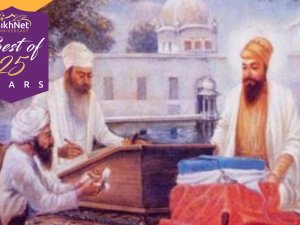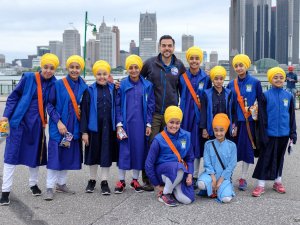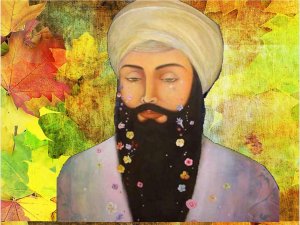There has been much debate and controversy by certain groups surrounding the authenticity of Raagmaala and its position within Guru Granth Sahib Ji. Here I will attempt to explain the background to Raagmaala and why Guru Arjan Dev Ji wrote and added this particular Baani.
Raag or Raga as we know them to be is the classical melodic modes of traditional Indian music, thought to evoke specific emotions of the mind and moods of a particular time of day or season. Derived from Sanskrit, Raga means the act of colouring or dyeing. In the context of Gurbani, it is the act of colouring or dyeing the mind with the Lord's Name. Nevertheless, Ragas are not mere musical modes, but were in fact a generation of aristocratic kings and queens, where celestial musical ballads were attributed to them.
Raja Aasa was the son of Raja Sarang. He was a very beautiful prince. His step mother wrongly accused him of committing a crime and ordered for him to be punished. His punishment was to have both his hands and feet chopped off. The executioner hacked off one hand and left Raja Aasa in another town. Raja Aasa became a servant to a laundress. The king of that village passed away. He had no children. There was no one left to take over his reign. The courtiers made a decision that the next person who enters the door will be made King of this city.
The laundress' cow escaped and Raja Aasa went looking for it. Thinking he saw the cow, Raja Aasa entered the doors of the King's palace. The guards seized Raja Aasa and took him to the minister, who after much deliberation declared him the next King. After some time, Raja Sarang passed away and his other son, the step brother of Raja Aasa, Sardhool Rai seized the kingdom. He waged a war against Raja Aasa. Raja Aasa won the battle. In praise of Raja Aasa's, the court poets composed a ballad, which corresponded to Raja Aasa's heroic defeat of Sardhool Rai.
The sixth Guru, Guru HarGobind Sahib Ji decided that Aasa Ki Vaar should be sung in Tundeh Aas Rajeh Ki Dhuni, meaning that the Baani should be sung in the tune of the ballad attributed to Raja Aasa, which produces the martial and heroic essence of victory.
Within Gurbilas Patshahi 6, written by Shaheed Bhai Mani Singh Ji, it tells us that during the time when Guru Arjan Dev Ji began to compile the Aad Granth at Sri Ramsar Sahib, the Ragas appeared before the Guru. The Ragas sang the praises of Guru Arjan Dev Ji and the previous four Gurus and thanked them for having blessed their ancestors. The Ragas made a supplication before Guru Arjan Dev Ji to give them a place within the Aad Granth and may they continue singing the Lord's praises when invoked through their musical form. The Ragas not only wanted to attain salvation through the sweet ambrosial nectar of the Guru's Words but to produce the ultimate experience of supreme bliss and inner peace to the mind and soul when the Divine Words are sung through the various harmonious styles of Ragas.
sathigur th paaeiaa sehaj saethee man vajeeaa vaadhhaaeeaa ||
I have found the True Guru, with intuitive ease, and my mind vibrates with the music of bliss.
raag rathan paravaar pareeaa sabadh gaavan aaeeaa ||
The jewelled melodies and their related celestial harmonies have come to sing the Word of the Shabad.
(Guru Amar Das Ji; GGSJ: Ang 917)
Fulfilling the supplication of the Ragas, Guru Arjan Dev Ji sequenced the compositions and hymns within the Aad Granth according to the traditional Indian musical measures to not only emphasise the Divine Message but to arouse heavenly experiences through devotional worship of the Lord. In total, thirty-one Ragas were selected.
raag rathan pareeaa paravaar ||
The divine crystalline harmonies, their consorts, and their celestial families
this vich oupajai a(n)mrith saar ||
from them, the essence of Ambrosial Nectar is produced.
(Guru Nanak Dev Ji; GGSJ: Ang 351)
Upon completing the Aad Granth with the musical measures in place, Guru Arjan Dev Ji sealed the Granth with an epilogue of the Ragas, known as Raagmaala, the garland of musical measures. Here Guru Arjan Dev Ji evokes and tributes the Almighty Lord through the form of Ragas. The formation of the Raagas strung or beaded into a garland or string emphasises the message, although we may have different qualities and forms, in essence we are all strung or unified by the One Creator, where there is no beginning or end.
In a similar way within Sri Dasam Granth, Guru Gobind Singh Ji evokes and praises the Lord in the form of weapons in his composition of Shastar Naam Maala (The Garland of Weapons).
It is believed that Raagmaala represents the lotus feet of the Guru (represented by the 'Maala') and the Jap Ji is thought to be the head of the Guru, which is full of Divine Wisdom and Knowledge. Those groups who are driven by their own irrational intellect and foolishly dismiss Raagmaala upon completing an Akhand Paat or Sehaj Paat, their Akhand Paat and Sehaj Paat will forever remain incomplete. Gurbilas Patshahi 6 further reinforces this:
ਰਾਗ ਮਾਲਾ ਪੜ ਪ੍ਰੇਮ ਸੋਂ, ਭੋਗ ਜਪੁਜੀ ਤੇ ਪਾਏ॥
When completing an Akhand Paat, read Raag Maala with love, Bhog (completion) is after Jap Ji Sahib has been fully read.
ਰਾਗ ਮਾਲਾ ਪੜ ਹੋਵਤ ਪੂਰਾ॥
An Akhand Paat Sahib can only be complete once Raag Mala has been read.
ਰਾਗ ਮਾਲਾ ਬਿਨ ਪਾਠ ਅਧੂਰਾ॥
Without Raag Mala, the Akhand Paat is incomplete.
Note: The above image is of a hand written Guru Granth Sahib being cared for at Takht Sri Patna Sahib and contains Raagmaalaa.
Related Articles:
Part II: Bhagat Angra ji and Bhagat Bidar
Part III: Sri Dhru Bhagat & Sri Prahladh Bhagat ji
Part V: The Story of Bhagat Sudama
Part VI: The story of Gotam Muni & Ahalia
Part VII: The Story of Raja Janak
Part VIII: The Story of Raja Bali
Part IX: The Story of Ajraja-Akrur
Part X:The Story of Bhisham Pitaama
Part XI: The Story of Chandar Hans
Part XII: The stories of Durbaasha Rishi and Gajinder (the Elephant)
Part XIII:The Stories of Kubija Maalan and Oudhar
Part XIV:The Story of Sarvan Bhagat
Part XV: The Story of Rishi Balmeek
Part XVI: The Stories of Sankaadik and Rukmaangudh
Part XVII: The Story of Sukdev Muni
Part XVIII: Madhusudan Demon Destroyer
Part XXI: Sulhi & Sulbi Khan's Evil Conspiracy
Part XXII: The Story Raja Hari Chand





